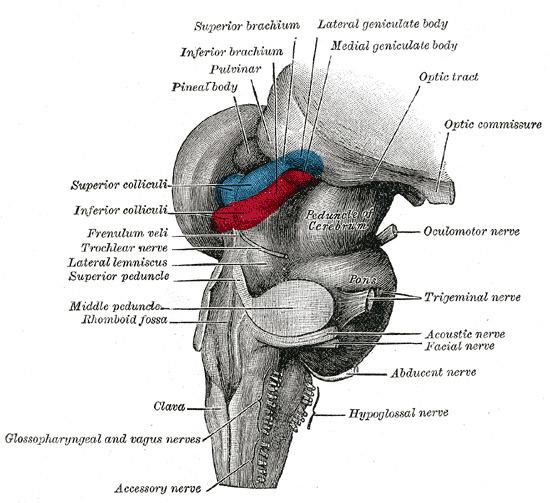NeuroLex ID Pulvinar | NeuroNames hier-311 Dorlands/Elsevier p_42/12680162 | |
 | ||
Latin nuclei pulvinaris (the nuclei plurally); pulvinar thalami (the set of nuclei singularly) MeSH A08.186.211.730.385.826.701.485.600 | ||
The pulvinar nuclei or nuclei of the pulvinar (nuclei pulvinares) are the nuclei (cell bodies of neurons) located in the thalamus (a part of the vertebrate brain). As a group they make up the collection called the pulvinar of the thalamus (pulvinar thalami), usually just called the pulvinar.
Contents
The pulvinar is usually grouped as one of the lateral thalamic nuclei in rodents and carnivores, and stands as an independent complex in primates.
Structure
By convention, the pulvinar is divided into four nuclei:
Their connectomic details are as follows:
Clinical significance
Lesions of the pulvinar can result in neglect syndromes and attentional deficits.
Other animals
The pulvinar varies in importance in different animals: it is virtually nonexistent in the rat, and grouped as the lateral posterior-pulvinar complex with the lateral posterior thalamic nucleus due to its small size in cats. In humans it makes up roughly 40% of the thalamus making it the largest of its nuclei. Significant research has been undertaken in the marmoset examining the role of the retinorecipient region of the inferior pulvinar (medial subdivision), which projects to visual cortical area MT, in the early development of MT and the dorsal stream, as well as following early-life lesions of the primary visual cortex (V1).
Etymology and pronunciation
The word pulvinar (English /pəlˈvaɪnər/) comes to scientific English vocabulary via New Latin from classical Latin pulvinus, "cushion". In the religion of ancient Rome, a pulvinar was an empty throne, a cushioned couch for occupation by a deity. Like the cervix uteri is usually just called the cervix (with "which cervix" being implicit), the pulvinar thalami (pulvinar of the thalamus) is usually just called the pulvinar (with "which pulvinar" being implicit); no other anatomic structure in today's Terminologia Anatomica is called a pulvinar, although in older terminology a part of the glomus body was called the pulvinar tunicae internae segmenti arterialis anastomosis arteriovenae glomeriformis. Each pulvinar nucleus (nucleus pulvinaris) has its own set of cortical connections.
